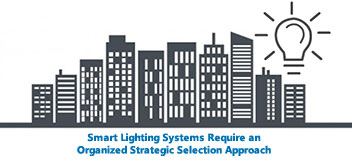




This comprehensive technology and supplier selection guide can simplify the selection process for implementing Smart Lighting Systems.
The four main pillars of building automation systems are HVAC, lighting, security, and life safety. A typical lighting control system consists of software platforms and applications plus a network of functionally and/or geographically distributed intelligent devices used for automated control of light fixtures. Software includes light management platforms, embedded control software, thin client applications, and a wide range of software typically sold bundled with a system. Today, Smart Lighting Systems is the trend.
Lights are ubiquitous and are found in building interiors and on exteriors, as well as illuminating infrastructure such as bridges, tunnels, parks, and streets. To properly manage all the various aspects to the illumination infrastructure, a comprehensive approach is required so that organizations can start implementing smart lighting.
 One of the key learnings is that technology is an enabler for smart lighting, but not an end in itself. For building owners/managers, the key challenge is often organizational, this means that building staff need to be motivated, business processes adopted, responsible persons identified, and wage structure and incentives adjusted.
One of the key learnings is that technology is an enabler for smart lighting, but not an end in itself. For building owners/managers, the key challenge is often organizational, this means that building staff need to be motivated, business processes adopted, responsible persons identified, and wage structure and incentives adjusted.
If you’re thinking about implementing smart lighting or enlarging your current system, this comprehensive selection guide can simplify the technology and supplier selection process. The guide is based on years of research, extensive surveys, and interviews with global experts.
Many infrastructure organizations face similar problems when it comes to energy management. This report addresses the most common challenges, including:
For more information on this technology guide or to discuss how we can help you, please contact us.




